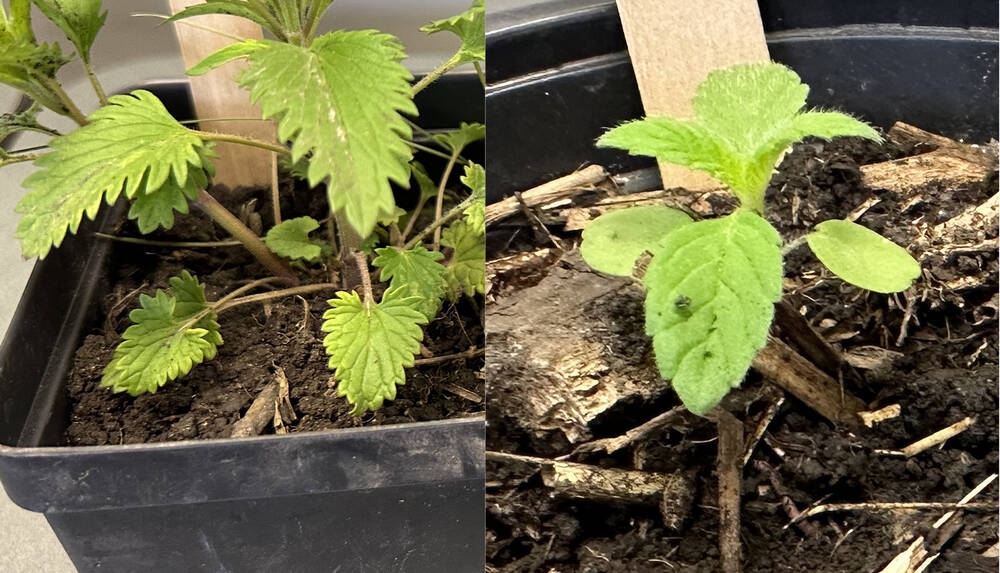Originally published on June 7, 2024 on Manitoba Co-operator
By Don Norman
Different weeds might warrant different responses if they’re found in a field. The problem is, they might look frustratingly similar in their early stages.
“You need to be going out for waterhemp or Palmer amaranth before they’re four inches tall,” said Manitoba Agriculture weed specialist Kim Brown.
Those species have provoked a lot of concern in Manitoba due to their tenacity and tendency to overcome herbicide chemistries. They’re a budding problem and farmers are generally advised to respond with no mercy. But if the weeds are mistaken for the common and virtually indistinguishable redroot pigweed, they might miss the critical control window.
Why it matters: Identifying weeds early can help farmers avoid bigger problems later in the season.
Leaf shape, leaf margins and venation — the branching pattern of leaf veins — all offer clues to weed identity, as can leaf structure. The various shapes include round (orbicular), arrow (hastate), kidney (reniform), wedge (cuneiform), lance (lanceolate), narrow (linear), deeply cut (dissected), heart (chordate), football (elliptic), oblong and egg-shaped (obovate, tip rounded or ovate, tip narrowed).
When telling young American dragonhead apart from hemp-nettle, venation is a major hint.
“The only way you can tell American dragonhead and hemp-nettle apart at this stage is whether the veins go to the tip or to the notch,” said Brown.
American dragonhead leaf veins flow to the tips of each serrated tooth on the leaf. Hemp-nettle leaves end at the notch between teeth. The same is true for water parsnip and water hemlock; veins in water parsnip leaves go to the notch.
Another identifying factor is whether the leaf arrangement is opposite or alternate. Opposite leaves grow straight across from each other on the stem.
“They come from the same node, and because they grew at the same time, they’re going to be the same size,” Brown said. “It’s very nice and ordered.”
Alternate leaves grow out from all around the stem in any direction.
Weeds will be one or the other, but Brown warned that some pull a switch-hit.
“They will start opposite and then (become) alternate, so that’s always fun,” she said, indicating ragweeds.
It can be difficult to accurately determine leaf arrangement.
“You have to be really careful with some of these plants. Sometimes it’s hard to tell whether or not they’re opposite because the inner nodes are so short.”
Hairs on leaves or other parts of the plant are another tell-tale factor. Hairiness is probably one of the most important factors to look for when distinguishing waterhemp or Palmer amaranth from redroot pigweed.
“The redroot pigweed is hairy, and waterhemp and Palmer amaranth have a very smooth feeling,” Brown said. “The hairs actually make it feel rough. To me, when feeling the stem of a redroot pigweed, I think it feels like fine-grit sandpaper, but it’s not sharp. It just feels rough and bumpy.”
Likewise, leaf hairs help distinguish canola from wild mustard.
“Sometimes you see the odd little bit of hair on canola when it’s really small, but usually if it’s hairy, it’s wild mustard,” said Brown.
Other important factors for plant identification include the plant’s life cycle (annual, biennial or perennial); habit of growth (erect or prostrate) and root traits, rhizomes and other underground structures, “especially seeds,” said Brown.
For a quick and dirty way to identify weeds, she suggested Google Lens, an app available for smart phones.
“I don’t really use apps because I don’t really need them. But the Google Lens app gets quite close a lot of times, which is surprising.”
Early days
To identify grass, at least one true leaf is needed. Since most grass leaves look similar, bend the leaf back where it comes out of the stem and look for the auricle, an ear-like appendage that wraps around the stem, and the ligule, a flap of tissue or fringe of hairs where the leaf joins the stem.
The ligule “can be a bunch of different shapes,” said Brown. “There can be hairs; it can be a plasticky-looking thing, as with oats.”
Auricles on barley are “very long, and they’ll almost look like they’re wrapping right around the stem. Barnyard grass is known for not having anything. It doesn’t have an auricle; it doesn’t have any ligules and, when you bend it backwards, it should be nice and shiny inside.”
Cotyledons can also winnow things down. Brassica species all have distinctive kidney-bean-shaped cotyledons.
Brown said the cotyledon will sometimes fall off early on broadleaf weeds, making it difficult to identify a true leaf or cotyledon. But even if they have fallen off, the scars where the cotyledons grew along the stem should be perceptible to touch.
Manitoba Agriculture publishes a Weed Seedling Identification Guide on its website. It’s been a while since that resource was updated, although Brown said that process is in the works. She hopes to have it complete by next year.

